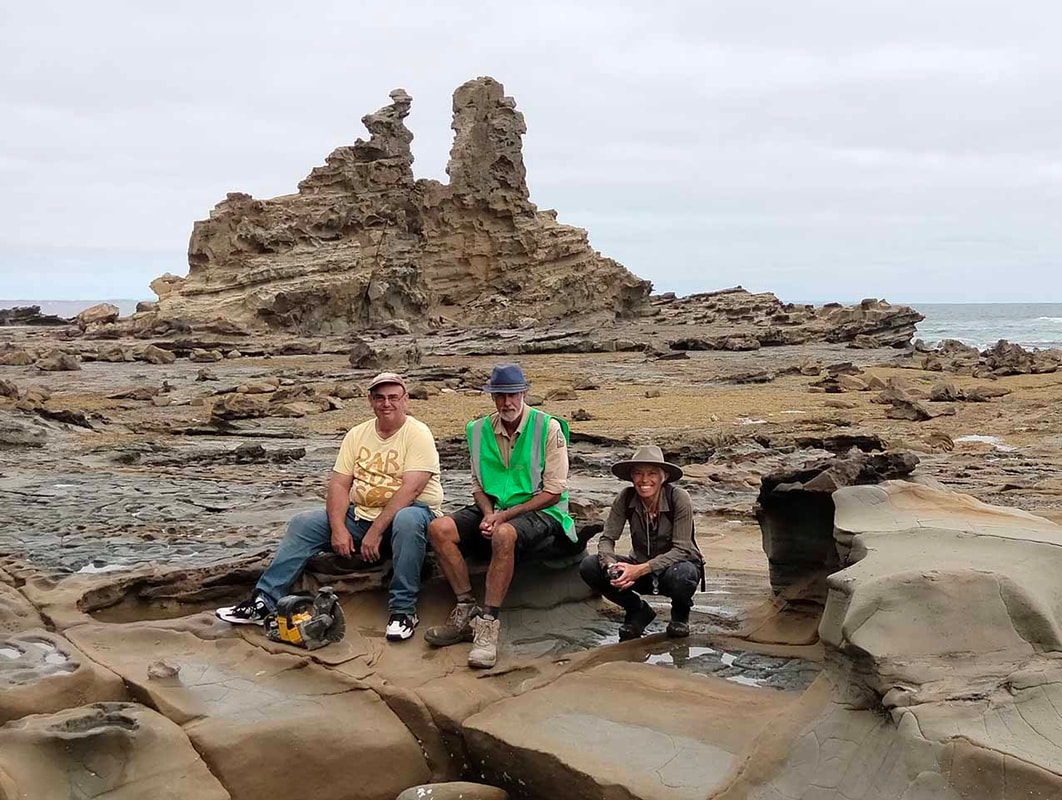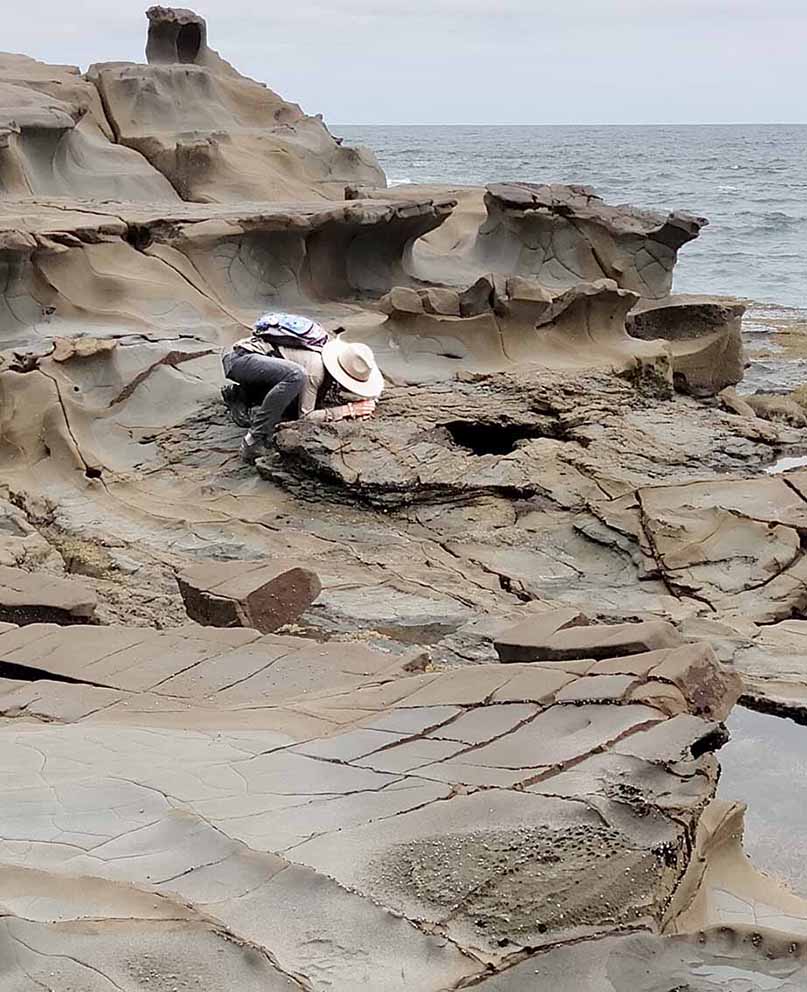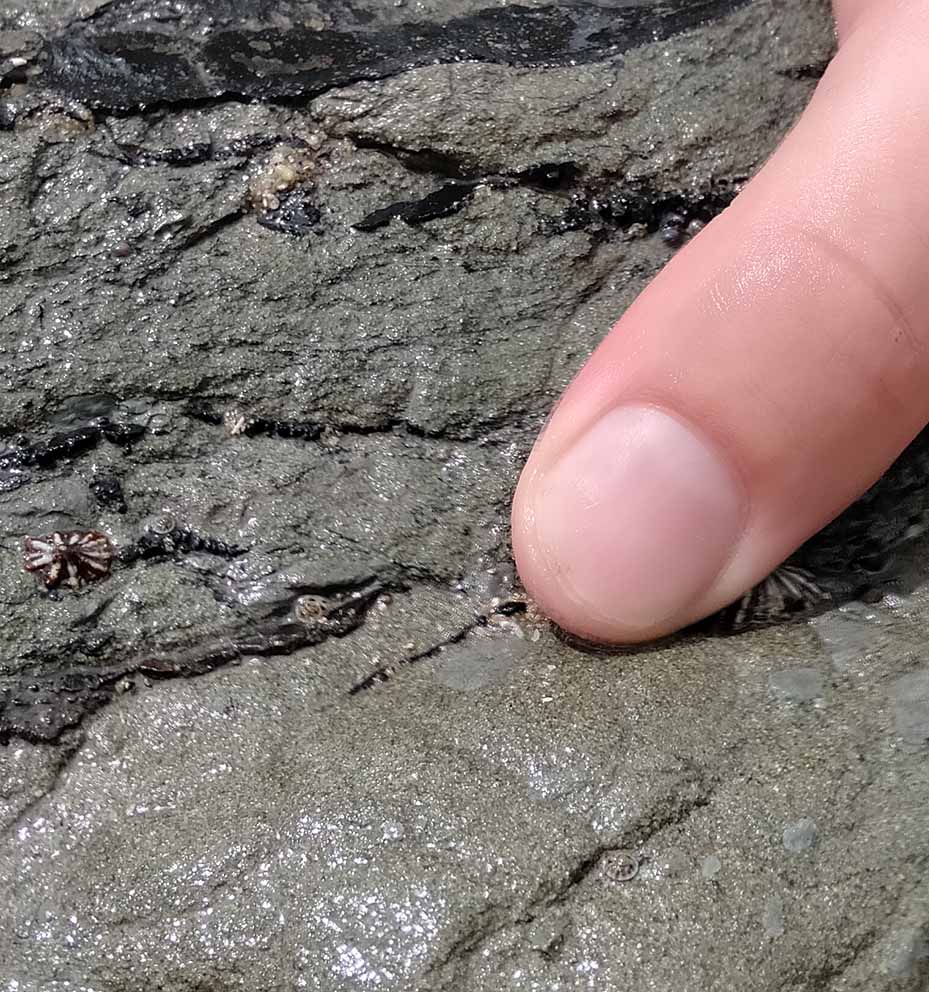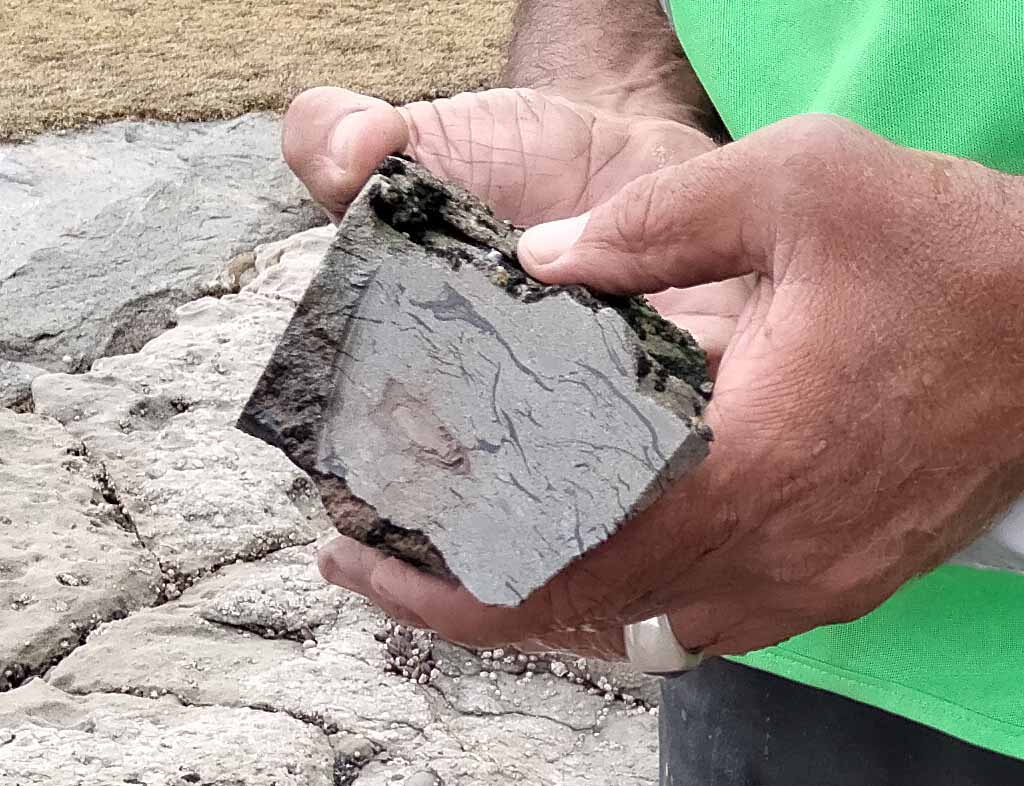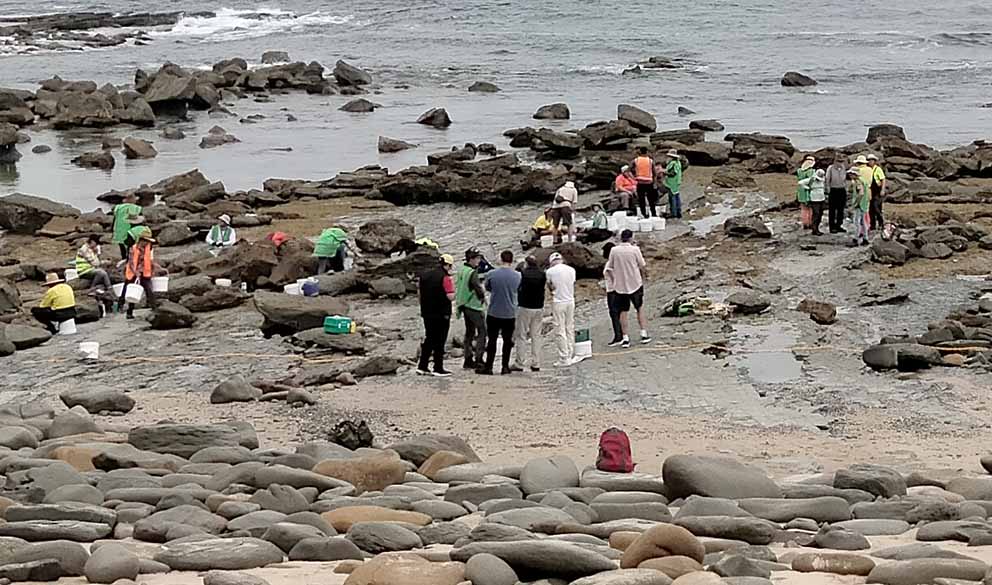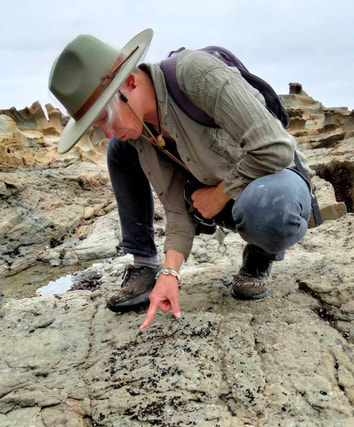 Melissa Lowery is transforming our knowledge of the
Melissa Lowery is transforming our knowledge of the dinosaurs that once roamed Bass Coast.
By Catherine Watson
WHEN someone suggests the dinosaur bones are calling to Melissa Lowery, she doesn’t disagree. Melissa sees things that no one else does. In the midst of one of Bass Coast’s many jumbled, multi-coloured, rocky sea shelves, she can pick out a tell-tale speck or splodge that might just be part of a creature that walked here 125 million years ago.
Her colleagues on Dinosaur Dreaming call her “the electron microscope”. Mike Cleeland (‘Mr Dinosaur’) says her tally of bones is closing in on 500 and she has found over 100 dinosaur footprints in the rocks. Prints that most of us would never notice, although once they’re pointed out you wonder how you could have missed them.
And here’s the funniest thing. Melissa is not a trained palaeontologist or geologist. She is a citizen scientist, part of an old tradition of an amateur making a major contribution to science.
Her extraordinary abilities have transformed the search for fossils of dinosaurs and other prehistoric creatures along the stretch of coast between Inverloch and San Remo.
WHEN someone suggests the dinosaur bones are calling to Melissa Lowery, she doesn’t disagree. Melissa sees things that no one else does. In the midst of one of Bass Coast’s many jumbled, multi-coloured, rocky sea shelves, she can pick out a tell-tale speck or splodge that might just be part of a creature that walked here 125 million years ago.
Her colleagues on Dinosaur Dreaming call her “the electron microscope”. Mike Cleeland (‘Mr Dinosaur’) says her tally of bones is closing in on 500 and she has found over 100 dinosaur footprints in the rocks. Prints that most of us would never notice, although once they’re pointed out you wonder how you could have missed them.
And here’s the funniest thing. Melissa is not a trained palaeontologist or geologist. She is a citizen scientist, part of an old tradition of an amateur making a major contribution to science.
Her extraordinary abilities have transformed the search for fossils of dinosaurs and other prehistoric creatures along the stretch of coast between Inverloch and San Remo.
Melissa's childhood interest in dinosaurs was reignited during a dinosaur walk with Mike on one of his summer programs in 2017. On that first walk she picked up a rock and noticed something. It was a small dinosaur bone. She was hooked.
In the midst of major health challenges, the search for fossils also gave her a purpose in life: to contribute to knowledge of the prehistoric animals that inhabited our part of the world.
In the midst of major health challenges, the search for fossils also gave her a purpose in life: to contribute to knowledge of the prehistoric animals that inhabited our part of the world.
*****
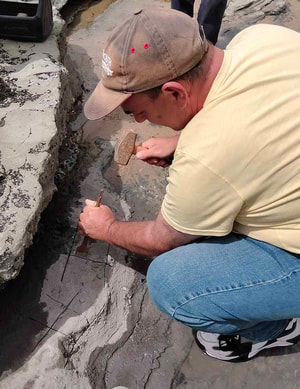
Mike wields a rocksaw to slice a section of rock, then Steve and Liam break it out with a hammer and chisel. While they’re at work, Melissa explains what we’re observing.
We’re on what used to be a vast floodplain. That grey stuff is the mudstone. It’s built up layer by layer. Each layer could represent hundreds of thousands, even millions, of years. Most of the sediments here have been dated at about 125 million years. Then the river has migrated over, ripping up the mudstone and bones and covering it with sand.
“Generally you find a lot of stuff at the base of the channels and this is what we’re looking at. I can never say this damned word. It’s … fossiliferous. Mike and I call it juicy … because there are lots of bones!”
She never tires of the hunt. Living in Inverloch, she’s out on the rocks at least two or three times a week, sometimes every day if the tides are right. “It’s addictive.”
While she’s talking, her eyes ceaselessly scan the rocks looking for the tell-tale signs of past life. “A nice big tree coming through here. It’s probably the roots. And again, these blobs. There may well be stuff underneath. It just hasn’t eroded out yet. So it’s absolutely wonderful.”
We’re on what used to be a vast floodplain. That grey stuff is the mudstone. It’s built up layer by layer. Each layer could represent hundreds of thousands, even millions, of years. Most of the sediments here have been dated at about 125 million years. Then the river has migrated over, ripping up the mudstone and bones and covering it with sand.
“Generally you find a lot of stuff at the base of the channels and this is what we’re looking at. I can never say this damned word. It’s … fossiliferous. Mike and I call it juicy … because there are lots of bones!”
She never tires of the hunt. Living in Inverloch, she’s out on the rocks at least two or three times a week, sometimes every day if the tides are right. “It’s addictive.”
While she’s talking, her eyes ceaselessly scan the rocks looking for the tell-tale signs of past life. “A nice big tree coming through here. It’s probably the roots. And again, these blobs. There may well be stuff underneath. It just hasn’t eroded out yet. So it’s absolutely wonderful.”
Each summer since the late 1980s a team of professionals and volunteers has spent up to six weeks on dinosaur digs along our coast. This year the main dig is at Twin Reefs – based on 11 bones that Melissa spotted earlier – but on Monday a small team calls in to Eagles Nest first to extract a couple of turtle bone fossils.
The team consists of Mike, Melissa, Steve Broady, a Korumburra geologist, and Liam Grech, a Ryanston student.
The team consists of Mike, Melissa, Steve Broady, a Korumburra geologist, and Liam Grech, a Ryanston student.
They are all volunteers, though Steve is also a trained geologist. “I have the qualification but I would come nowhere near Mike’s knowledge,” he says. As for finding bones, he says, no one can compete with Melissa. “The last one I found was about eight years ago. The glory is well behind me at the moment!”
*****
The turtle fossil extracted, we move around the corner – taking care not to get too close to the cliff where Mike indicates a massive chunk is about to fall – to the spot where Australia’s first dinosaur fossil was found in 1903 by field geologist William Ferguson.
| After that nothing much happened for 75 years until a young Monash University science student called Tim Flannery asked Dr Tom Rich at Museums Victoria if he knew where the first dinosaur bone was found. Tom put him in touch with another field geologist, Rob Glenie, who had the Ferguson map. Together with Flannery’s cousin John Long, now also an eminent palaeontologist, they visited Eagles Nest and began finding bones. The major digs began in the 1980s. Mike Cleeland went on his first one in 1989 and thought they would find everything in five or ten years. “In fact, the opposite’s happened. The pace of discovery has picked up in recent years because people like Melissa have joined in and started finding things.” And the discoveries will never end. Dinosaur hunters – trained and amateur – might scour an area for fossilised bones, then leave nature to wear away more of the sandstone, before returning to inspect it again. In this historic spot, Melissa quickly spots a few more promising brown specks and splodges and Mike and Steve set to work. Each find is put into a labelled bucket, which will be dropped off to dig co-ordinator and fossil preparator Lesley Kool in Wonthaggi. She will expose the bones, hopefully to a point where they can be identified, before they go to Museums Victoria for storage and research. On the final splodge, Mike’s first cut slices through whatever it is and he has to make a second slice to extract the rest. He identifies it as an oblique cross-section of a limb. “That’s a bit more significant.” “Gee whizz!,” Melissa says. “That’s beautiful. That’s made my day!” |
*****
It’s hard to think of anything topping the excitement of Eagles Nest, but we head over to Twin Reefs to see what the main crew are doing. On a roped off section of the rock shelf, about 30 people are working intently. From a distance they look like a team of worker ants. Unsure of dinosaur dig etiquette, we wait for Mike to show us the ropes.
He explains the variety of skills on site. Dinosaur Dreaming is a joint project between Museums Victoria, Monash University and Swinburne University of Technology so of course there are lots of Monash students.
Mike points out Mike Hall, Professor of Geology at Monash University. And the legendary Tom Rich, Curator of Vertebrate Palaeontology at Museums Victoria. Tom’s wife, the equally famed palaeontologist Professor Patricia Vickers-Rich, is out of action at the moment.
There’s a professional sedimentologist and there are amateurs with special skills, including a salesman for auto parts who’s a pretty good rocksaw and jackhammer operator.
And there’s Zev Landes, a Phillip Island cartoonist and official artist with Dinosaur Dreaming, who's cartooning in situ.
Mike points out Mike Hall, Professor of Geology at Monash University. And the legendary Tom Rich, Curator of Vertebrate Palaeontology at Museums Victoria. Tom’s wife, the equally famed palaeontologist Professor Patricia Vickers-Rich, is out of action at the moment.
There’s a professional sedimentologist and there are amateurs with special skills, including a salesman for auto parts who’s a pretty good rocksaw and jackhammer operator.
And there’s Zev Landes, a Phillip Island cartoonist and official artist with Dinosaur Dreaming, who's cartooning in situ.
“The rest of them are rock breakers," Mike says. "You create a hole and you dig deeper. You break out lumps of rock, break them up into smaller bits and look for bones.”
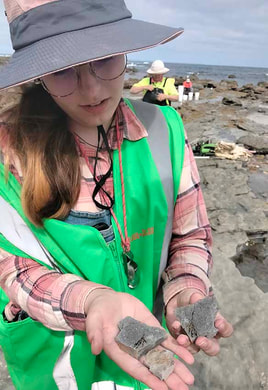 Leo Prezant with fern fossil
Leo Prezant with fern fossil Leo Prezant, a Monash University student, shows us what she's found: a delicate fern fossil that miraculously appeared when she broke a small rock. She’s studying genetics and ancient history but says that one day she attended a lecture on palaeontology and was entranced. This is her first dig. She’s staying at Cape Paterson in one of two share houses rented for the duration of the dig.
Jöerg Kluth of Inverloch, a former teacher and now an AutoCAD designer, explains how he became involved. “In 2012 I was walking along the beach and saw some people digging for fossils. The next year I became a part of it.”
This is his fifth big dig and he loves it, being a part of such a project. “This is the country of Australia and this is the culture.”
Which reminds me of something that Melissa Lowery said, about being part of something that’s bigger than an individual.
“It’s an honour to be doing this, to be honest. It really is. We’re talking about creatures that were alive, that were walking around in this exact environment. We’re learning more about them all the time. And that’s so exciting.”
As the tide turns, the diggers pack up for the day. The forecast is for more hot still weather and they’ll be back tomorrow. They carry buckets of rocks and hammers up the steep stairs. “Palaeontology can be exhausting work,” says Mike.
Thanks to filmmakers Terry Melvin and Laura Brearley who invited me to tag along. And to Mike, Melissa, Steve and Liam who were so generous with their knowledge.
Jöerg Kluth of Inverloch, a former teacher and now an AutoCAD designer, explains how he became involved. “In 2012 I was walking along the beach and saw some people digging for fossils. The next year I became a part of it.”
This is his fifth big dig and he loves it, being a part of such a project. “This is the country of Australia and this is the culture.”
Which reminds me of something that Melissa Lowery said, about being part of something that’s bigger than an individual.
“It’s an honour to be doing this, to be honest. It really is. We’re talking about creatures that were alive, that were walking around in this exact environment. We’re learning more about them all the time. And that’s so exciting.”
As the tide turns, the diggers pack up for the day. The forecast is for more hot still weather and they’ll be back tomorrow. They carry buckets of rocks and hammers up the steep stairs. “Palaeontology can be exhausting work,” says Mike.
Thanks to filmmakers Terry Melvin and Laura Brearley who invited me to tag along. And to Mike, Melissa, Steve and Liam who were so generous with their knowledge.
